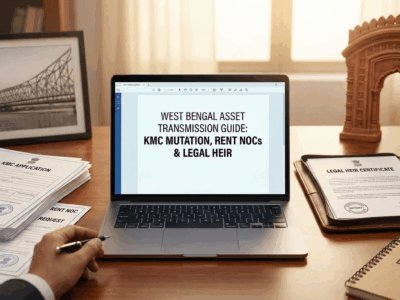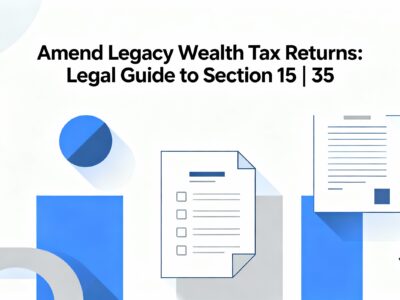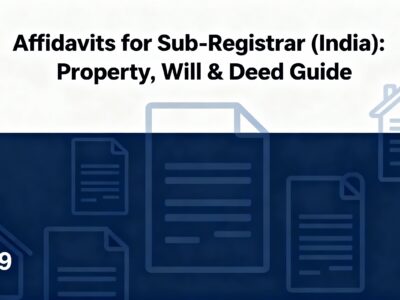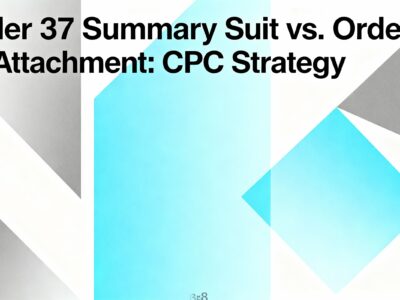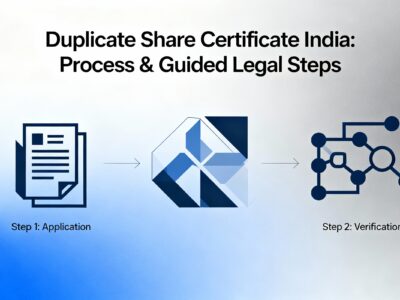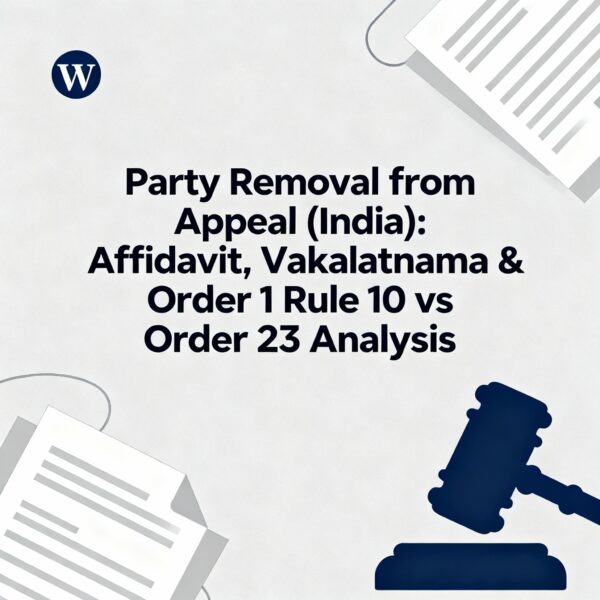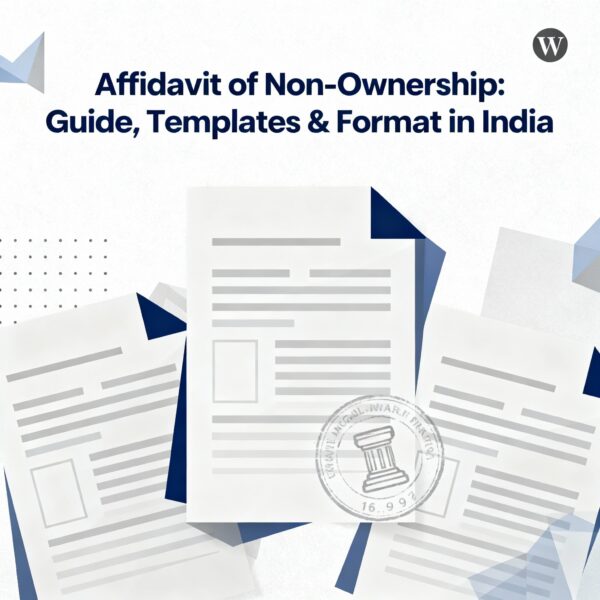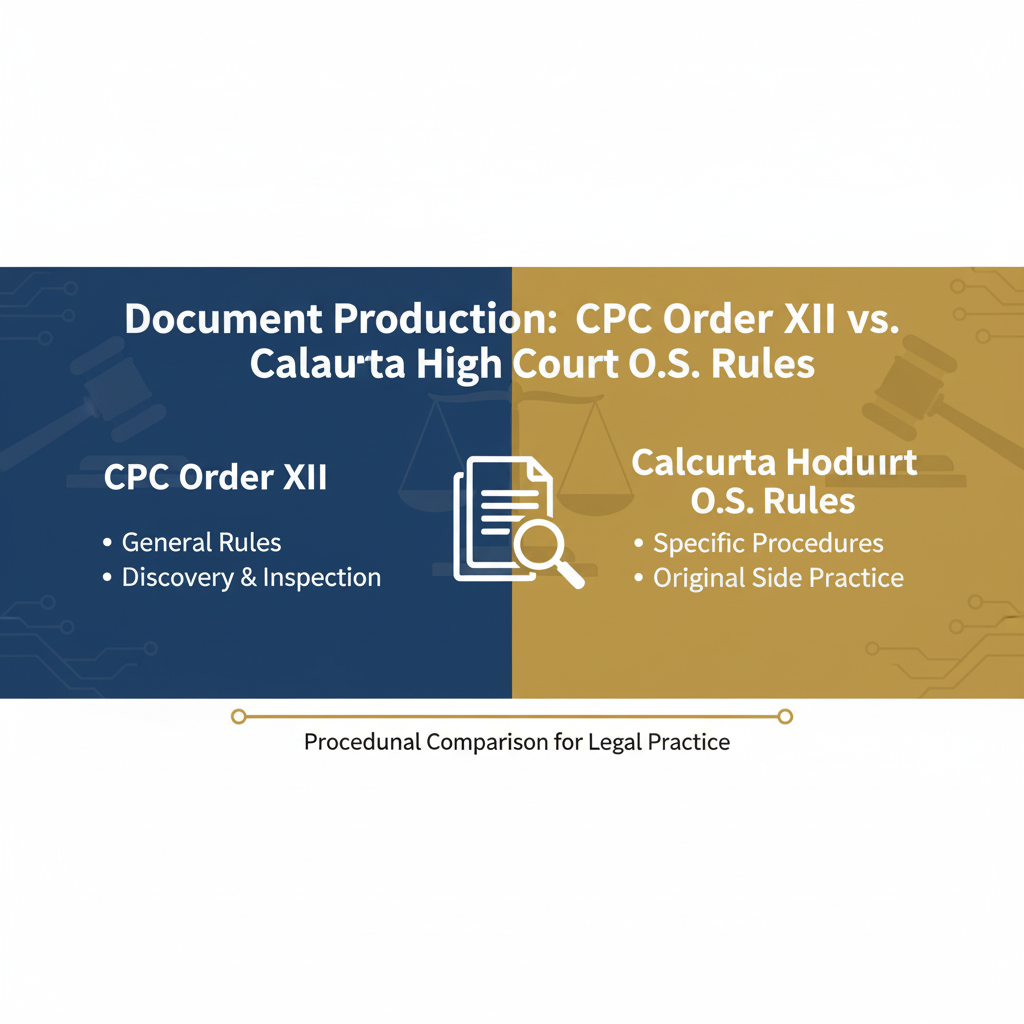Filing additional documents at a late stage in a civil suit in India is a critical procedural challenge. Governed by the Civil Procedure Code (CPC), parties who miss filing documents with their plaint (Order VII, Rule 14) or written statement (Order VIII, Rule 1A) must seek “leave of the Court.”
This is done by filing a formal Application (IA) supported by a sworn Affidavit. This comprehensive 2025 guide provides expert-drafted templates for this application and affidavit in English, Hindi, Tamil, Telugu, and Bengali, detailing the legal strategy to successfully prove “sufficient cause” for the delay.
Drafting Guide: Affidavit for Late Production of Documents in Indian Civil Litigation
A comprehensive guide for legal practitioners on drafting and filing an Application and Affidavit to submit documents at a belated stage under the Civil Procedure Code.
Introduction: The Procedural Hurdle
In the lifecycle of a civil suit in India, the timely filing of documents is paramount. Order VII, Rule 14 (for Plaintiffs) and Order VIII, Rule 1A (for Defendants) of the Code of Civil Procedure, 1908, mandate that parties must file all documents in their possession or power upon which they rely.
But what happens when a critical document is discovered *after* this stage? The law provides a remedy, but it is not automatic. The party must seek "leave of the Court" to produce the document. This "leave" is sought by filing an Interlocutory Application (IA), commonly supported by an Affidavit. This affidavit is the cornerstone of the request; it must explain the delay and satisfy the court that the omission was neither intentional nor negligent.
Part 1: The Application (IA)
This is the formal 'request' to the court. It is a pleading that states the legal provision (e.g., S.151 CPC) and contains the 'prayer' asking for permission to file the documents.
Part 2: The Affidavit
This is the 'evidence' in support of the application. It is a sworn statement by the party explaining the facts: what the document is, why it is relevant, and the *specific reason* for the delay.
A common procedural error is to combine these, placing the prayer `inside` the affidavit. This guide clarifies the correct procedure, provides robust templates, and examines the legal standard of "sufficient cause" that courts use to grant (or deny) such requests.
Case Study: Analysis of a Common Flawed Affidavit
The impetus for this guide comes from a frequently circulated template that contains critical, and often fatal, procedural flaws. Let's analyze it to understand what to avoid.
Critique of the Sample Document
The sample affidavit provided demonstrates two primary errors:
- Flaw 1: Combining Prayer and Affidavit. The sample ends with a prayer: "It is therefore prayed that the Hon'ble Court may be pleased to condone the delay...". An affidavit is a statement of *evidence*, not a *request* (pleading). The prayer belongs exclusively in the Application (IA). This confuses the court and is procedurally incorrect.
- Flaw 2: Weak "Sufficient Cause". The reason given is: "...document was kept in bank locker and due to holidays in bank, I was not able to take it from there...". This is a textbook example of *insufficient* cause. It demonstrates a lack of diligence, not an unavoidable event. A court would rightly ask why the document wasn't retrieved *before* the holidays or *immediately after*.
This flawed structure is why the two-document approach (Application + separate Affidavit) is essential for success. This guide provides that correct, procedurally sound structure.
Part 1: The Legal Templates
Filter Templates by:
This is the Interlocutory Application (IA) filed by the Plaintiff, seeking permission under Section 151 CPC to place new documents on record. It must be supported by an affidavit.
IN THE COURT OF [NAME OF COURT], [CITY]
CS OS NO. ____ OF 20__
IN THE MATTER OF:
[Mr. ______ & Ors] ... Petitioners / Plaintiffs
VERSUS
[Mr. ______________] ... Respondent / Defendant
APPLICATION UNDER SECTION 151 OF THE CODE OF CIVIL PROCEDURE, 1908, ON BEHALF OF THE PLAINTIFF FOR LEAVE TO PLACE ON RECORD ADDITIONAL DOCUMENTS
MOST RESPECTFULLY SHOWETH:
1. That the above-titled suit is pending before this Hon'ble Court and is currently fixed for [Current Stage of Suit, e.g., "Plaintiff's Evidence"] on [Date].
2. That the Plaintiff filed the present suit for [Nature of Suit, e.g., "Specific Performance of an Agreement to Sell dated ____"].
3. That at the time of filing the suit, the Plaintiff filed all documents in his possession and power. However, the Plaintiff inadvertently missed filing [Brief Description of Document, e.g., "the original Agreement to Sell dated ____"].
4. That the reason for this omission is detailed in the Affidavit filed in support of this application. [Briefly state reason, e.g., "The document was kept in a bank locker which could not be accessed at the time due to..."]
5. That the aforementioned document is vital for the just and proper adjudication of this suit, and no prejudice will be caused to the Defendant if the same is taken on record. The Plaintiff is willing to compensate the Defendant with costs, if any, imposed by this Hon't Court.
6. That this application is made bona fide and in the interests of justice.
PRAYER
It is, therefore, most respectfully prayed that this Hon'ble Court may be pleased to:
a) Grant leave to the Plaintiff to place on record the [Name of Document, e.g., "original Agreement to Sell dated ____"];
b) Pass such other order or orders as this Hon'ble Court may deem fit and proper in the facts and circumstances of the case.
PLAINTIFF
Through
[COUNSEL FOR PLAINTIFF]
[Date]
[Place]
This is the critical affidavit. It must be sworn by the party (not the lawyer) and clearly explain the "sufficient cause" for the delay. This template provides a general structure.
IN THE COURT OF [NAME OF COURT], [CITY]
CS OS NO. ____ OF 20__
IN THE MATTER OF:
[Mr. ______ & Ors] ... Petitioners / Plaintiffs
VERSUS
[Mr. ______________] ... Respondent / Defendant
AFFIDAVIT IN SUPPORT OF THE APPLICATION U/S 151 CPC
I, [Full Name of Deponent], son of [Father's Name], aged about [Age] years, resident of [Full Address], do hereby solemnly affirm and declare as under:
1. That I am the Plaintiff in the above case and the deponent herein, and as such, I am fully conversant with the facts and circumstances of the case.
2. That I have filed an application under Section 151 CPC for leave to place on record additional documents. The contents of the said application have been read and explained to me in vernacular and are true and correct, and the same may be read as part of this affidavit to avoid repetition.
3. That the suit is pending for [Stage of Suit].
4. That at the time of filing the suit, I had handed over all relevant papers to my counsel. However, the document in question, [Name of Document], was inadvertently [State the *precise* reason for the delay. E.g., "kept in a bank locker at ____," "misplaced in my old office files," "in the possession of my relative, Mr. ____, who was out of the country," etc.].
5. That I was under the bona fide belief that all documents had been filed.
6. That recently, on [Date of Discovery], while [Action that led to discovery, e.g., "conducting a search for separate taxation documents," "my relative returned and handed me the file," etc.], I found the said document.
7. That I immediately, on [Date], provided the same to my counsel with instructions to file it before this Hon'ble Court without any delay.
8. That the delay in filing the said document is unintentional and due to the bona fide reasons stated above.
9. That the document is extremely relevant for the just decision of this case, and its non-production would cause irreparable loss and injury to me.
10. That no prejudice shall be caused to the Respondent if this document is taken on record, and any such prejudice can be compensated by costs.
DEPONENT
VERIFICATION
Verified at [City] on this __ day of ____, 20__, that the contents of my above affidavit (paras 1 to 10) are true and correct to my knowledge and belief, and nothing material has been concealed therefrom.
DEPONENT
This IA is for the Defendant. The structure is similar, but the context is in relation to the Written Statement (WS) and the evidence stage.
[Case Title and Court as above]
APPLICATION UNDER SECTION 151 OF THE CODE OF CIVIL PROCEDURE, 1908, ON BEHALF OF THE DEFENDANT FOR LEAVE TO PLACE ON RECORD ADDITIONAL DOCUMENTS
MOST RESPECTFULLY SHOWETH:
1. That the above-titled suit is pending before this Hon'ble Court and is currently fixed for [Current Stage of Suit, e.g., "Defendant's Evidence"].
2. That the Defendant filed his Written Statement on [Date], along with all documents in his possession and power.
3. That the Defendant now seeks to file [Brief Description of Documents, e.g., "a series of email correspondence between the Defendant and the Plaintiff from January 20__"].
4. That these documents were not filed with the Written Statement as they were stored on an old computer hard drive which had become corrupted and was inaccessible to the Defendant.
5. That the Defendant only recently was able to recover the data from the said hard drive on [Date of Recovery] through a professional data recovery service. The details of this are stated in the accompanying Affidavit.
6. That the said email correspondence is vital to proving the Defendant's case, specifically that [Brief relevance, e.g., "the Plaintiff was aware of the property's defect"].
7. That no prejudice will be caused to the Plaintiff, who is the author/recipient of the said emails, and any perceived delay can be compensated by costs.
8. That this application is made bona fide and in the interests of justice.
PRAYER
It is, therefore, most respectfully prayed that this Hon'ble Court may be pleased to:
a) Grant leave to the Defendant to place on record the [Name of Documents, e.g., "email correspondence dated ____"];
b) Pass such other order or orders as this Hon'ble Court may deem fit.
DEFENDANT
Through
[COUNSEL FOR DEFENDANT]
[Date]
[Place]
The affidavit supporting the Defendant's application. This one uses the "data recovery" reason, which is a common and specific example of "sufficient cause."
[Case Title and Court as above]
AFFIDAVIT IN SUPPORT OF THE APPLICATION U/S 151 CPC
I, [Full Name of Deponent], son of [Father's Name], aged about [Age] years, resident of [Full Address], do hereby solemnly affirm and declare as under:
1. That I am the Defendant in the above case and the deponent herein, and as such, I am fully conversant with the facts and circumstances of the case.
2. That I have filed an application under Section 151 CPC for leave to place on record additional documents. The contents of the said application are true and correct and may be read as part of this affidavit.
3. That the suit is pending for Defendant's Evidence.
4. That at the time of filing my Written Statement, I was unable to locate certain email correspondence that was highly relevant to my defence.
5. That I recall that this correspondence was stored on my old office computer, which had stopped working in or around [Month, Year]. The hard drive of the said computer was corrupted.
6. That I had given the said hard drive to [Name of Data Recovery Service] for data retrieval on [Date].
7. That despite my best efforts, the data could only be successfully recovered on [Date of Recovery]. A copy of the receipt from the data recovery service is annexed hereto as Annexure A.
8. That upon reviewing the recovered data, I found the email correspondence which I now seek to place on record.
9. That I immediately provided the same to my counsel for filing in court.
10. That the delay in filing the said document is unintentional and was due to circumstances beyond my control.
11. That the document is vital for the just decision of this case.
DEPONENT
VERIFICATION
Verified at [City] on this __ day of ____, 20__, that the contents of my above affidavit (paras 1 to 11) are true and correct to my knowledge and belief, and nothing material has been concealed therefrom.
DEPONENT
Key Legal Provisions at a Glance
O. VII, R. 14(3) CPC (Plaintiff)
(3) A document which ought to be produced in Court by the plaintiff when the plaint is presented, or to be entered in the list to be added or annexed to the plaint but is not produced or entered accordingly, shall not, without the leave of the Court, be received in evidence on his behalf at the hearing of the suit.
Effect: Bars the Plaintiff from using un-filed documents without court permission.
O. VIII, R. 1A(3) CPC (Defendant)
(3) A document which ought to be produced in Court by the defendant when the written statement is presented, or to be entered in the list to be added or annexed to the written statement but is not produced or entered accordingly, shall not, without the leave of the Court, be received in evidence on his behalf at the hearing of the suit.
Effect: Bars the Defendant from using un-filed documents without court permission.
Section 151 CPC (Inherent Powers)
Nothing in this Code shall be deemed to limit or otherwise affect the inherent power of the Court to make such orders as may be necessary for the ends of justice or to prevent abuse of the process of the Court.
Effect: This is the source of the court's power to grant 'leave' (permission) when no other rule applies.
Section 5, Limitation Act, 1963
...Any appeal or any application... may be admitted after the prescribed period, if the appellant or the applicant satisfies the court that he had sufficient cause for not preferring the appeal or making the application within such period.
Effect: Provides the "Sufficient Cause" test that courts use to evaluate applications for delay.
Part 2: The Legal Foundation
Understanding "Sufficient Cause"
The success of your application hinges on one concept: "sufficient cause" (a standard borrowed from Section 5 of the Limitation Act). The court has wide discretion, but it is guided by established principles. "Sufficient cause" is *not* a substitute for diligence. It must be a genuine, unavoidable, or bona fide reason.
Interactive: The "Sufficient Cause" Doctrine
Click or hover on the bars to see examples.
The chart visualizes the balance of justice. Reasons demonstrating a "Bona Fide Mistake" or "Events Beyond Control" are highly likely to be accepted. Conversely, reasons showing "Negligence" or "Lack of Diligence" are almost certain to be rejected. The court weighs the applicant's reason against the potential prejudice to the other side.
Part 3: Strategic Drafting Tips for the Affidavit
Your affidavit must be a persuasive narrative. It is not just a formality; it is your one chance to convince the judge.
- Be Specific and Chronological. Do not be vague. "I found the document" is weak. "On 15.10.2025, while searching my deceased father's bank locker for his Will, I discovered the original 2018 rent receipts..." is strong. Provide dates, names, and a clear timeline.
- Explain the "Why Now?". You must explain two things: 1) Why it was not filed earlier, and 2) Why it is being filed *now*. This demonstrates diligence *after* discovery. State that you "immediately" contacted your counsel upon finding the document.
- Annex Supporting Proof. If you claim the document was found after data recovery, annex the recovery service receipt. If it was due to a medical issue, annex the medical certificate. This adds immense credibility.
- Address Relevance and Prejudice. Clearly state *why* the document is "vital" and "necessary for the just adjudication." Also, pre-empt the opponent's argument by stating that "no prejudice" will be caused to them, as the document is genuine.
- Concede Costs (If Appropriate). Stating that the opponent can be "compensated by costs" is a powerful strategic move. It shows reasonableness and addresses any prejudice to the other side.
Part 4: Opposing the Application — A Respondent's Toolkit
What if you are on the receiving end of such an application? Your goal is to demonstrate to the court that the applicant has failed the "sufficient cause" test. Your reply affidavit should focus on exposing negligence, laches, and the prejudice your client will suffer.
Strategic Grounds for Opposition
- Argue Gross Negligence. The strongest opposition. Show that the "reason" for the delay is not an excuse but a clear admission of carelessness (e.g., "forgetfulness," "mismanagement of files," or "bank holidays"). The law does not protect the indolent.
- Demonstrate Laches (Unreasonable Delay). This is a powerful argument. Scrutinize the dates. If the applicant claims they "found" the document on January 1st but only filed the application on March 1st, this two-month gap is "laches" and proves they did not act diligently *even after discovery*.
- Highlight Prejudice to Your Client. Explain how this new document prejudices you. Does it change the entire nature of the case? Will you now have to cross-examine witnesses who were already discharged? Will it prolong the trial indefinitely? This shifts the "balance of justice" in your favor.
- Challenge the Document's Genuineness. If the circumstances are suspicious, you can suggest the document is an "afterthought" or has been "procured" late in the day to fill gaps in the applicant's case.
- Insist on Heavy Costs. As a fallback, if it seems the court is inclined to allow the document, argue that this should only be permitted upon payment of "heavy and exemplary costs" to compensate your client for the delay and additional work.
Concluding Professional Advice
While Section 151 CPC grants courts inherent powers to do justice, this power is not a backdoor for negligence. A well-drafted, honest, and specific affidavit is the key to unlocking that power. A vague or careless application will not only be dismissed (often with costs) but can also irretrievably damage your client's case by barring a determinative piece of evidence.
Disclaimer: This guide is for informational purposes only and does not constitute legal advice. The templates provided are samples and must be customized by a qualified legal professional to fit the specific facts and circumstances of your case.

